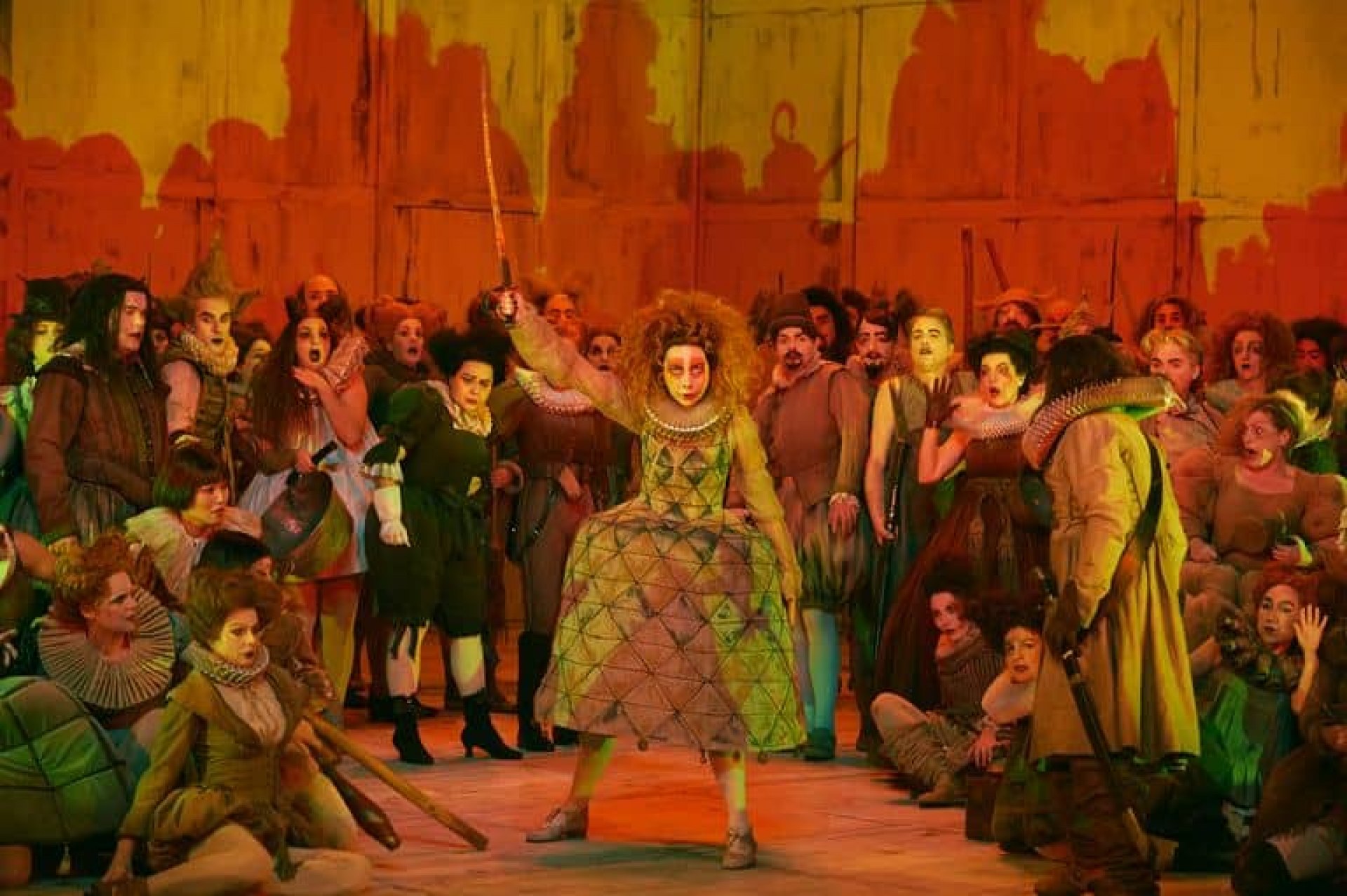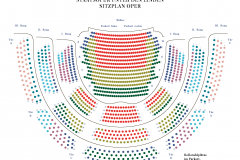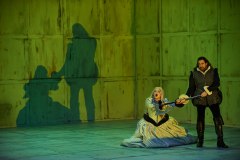The troubadour
Mo | Tu | We | Th | Fr | Sa | Su |
DRAMMA LIRICO IN FOUR ACTS (1853)
MUSIC BY Giuseppe Verdi
TEXT BY Salvatore Cammarano and Leone Emanuele Bardare after Antonio García Gutiérrez
Azucena had to witness her mother being burned as a witch. In revenge, she kidnapped the younger of the two sons of the old Count di Luna, who ordered her mother’s burning, but in her delirium she threw her own son onto the flames instead of the Count’s son. Years later, the new Count di Luna, the brother of the kidnapped child, and the »Troubadour« Manrico, the supposed son of Azucena, not only fight on opposing sides in a civil war, but also encounter each other because they both love the lady-in-waiting Leonora. Nobody suspects that Manrico is actually Luna’s kidnapped brother – until Leonora sacrifices herself for her beloved and the hate-filled Luna kills his rival.
Fascinated by the »strong situations« that arose from this bizarre constellation of plots and characters as well as the »boldness and novelty of the Spanish play«, Giuseppe Verdi created a work full of enrapturing bel canto numbers and elaborately dramatic orchestral parts that met with wild enthusiasm. The opera’s erratic and rather implausible plot was frequently and justifiably criticised, but scenes of atrocities, vengeance, madness, jealousy, love, despair and hate offered the composer an occasion to compose the extremely expressive melodies, emotionally charged arias and dramatic choruses that make »Il trovatore« a truly enthralling festival of song.
PLOT
In 15th century Spain, a conflict has broken out over succession to the throne between Ferdinand, the designated successor, and the Duke of Urgel. Count Luna favors Ferdinand, while Manrico supports the troops of the rebellious Urgel. Both love Leonora, a lady of the court. What the two enemies cannot know is that they are both brothers, because Manrico was stolen by a gypsy woman 15 years ago and raised as her own child.
PART ONE – The Duel
Count Luna jealously keeps watch each night at the balcony of his loved one. In the meantime, Ferrando, a captain of the count, tells his soldiers horrific stories of the House of Luna. The old count had two sons; the younger one was enchanted by a gypsy, who was then burned at the stake for her deed. The daughter of the gypsy then kidnapped the enchanted boy out of revenge, burning him to death. The current count, the brother of the kidnapped child, had to swear to his father that he would seek out the murderess his whole life long. And the ghost of the old gypsy still continued to haunt the castle.
In the deep of the night: Inez wants to remind her mistress Leonora of her courtly duties. But the latter confesses that she is waiting for Manrico. She fell in love with the younger man when he won a joust, then lost him from sight. Now he has returned from the battlefield and sings to her nightly. And his singing then sounds from the darkness. Ecstatically, Leonora rushes to meet her troubadour, but in the darkness falls into the arms of Luna. When Manrico appears, enraged, the count sees not only his competitor, but also a political enemy in the civil war. A life or death duel takes place, but the victorious Manrico is unable to kill the count.
PART TWO –The Gypsy
Morning twilight: somewhere in the distance, a group of gypsies has taken up camp. For some time now, the old Azucena has been tortured by memories of her mother’s fiery death. She tells her wounded son Manrico how she once kidnapped the son of the count, but then threw her own child into the flames because she was left bewildered by the death of her own mother. Manrico thus begins to realize that he could not be Azucena’s son, but she successfully distracts him with prevarications.
A messenger arrives: Manrico is to defend the fortress Castellor. Leonora decides to enter the convent, because she thinks her own lover has been dead since the duel. Manrico is furious and rushes off, ignoring the pleas of his mother.
Count Luna lurks outside the cloister. He wants to kidnap Leonora, who is preparing to take on the habit. A confusing struggle results when Manrico also arrives with his troops. Finally, Manrico is able to take Leonora to Castellor.
PART THREE – The Son of the Gypsy
Luna holds a siege against Castellor, defended by Manrico. Outside the walls, Azucena goes in search of her son. She is arrested as a spy and brought before Luna. But Ferrando recognizes the woman that once enchanted the younger brother of the count and burned him to death. Azucena is tortured and condemned to death by burning at the stake. Manrico and Leonora prepare an emergency wedding on the castle, when unexpectedly the news of Azucena’s conviction arrives. Manrico decides to save his mother.
PART FOUR – The Execution
Manrico’s attempt to free his mother fails. He is now also imprisoned with his mother; his sad songs can be heard from far off in the distance. Leonora, who was able to escape, wants to liberate him. She appears before Count Luna, and asks him to pardon Manrico. When he refuses, she offers herself in exchange for Manrico’s life. But secretly, Leonora takes poison to escape the count’s passion. Imprisoned, the dying Azucena is tortured by dark visions. Manrico is able to calm her; both dream of their old homeland. Already weakened, Leonora appears in the prison and tries to convince Manrico to flee. Because she does not want to flee with him, Manrico thinks she has been unfaithful. It is only when she dies in his arms that he understands that she has sacrificed herself for him.
Luna, who has observed the scene, now would like to make short shrift of his competitor and has him executed. After his death, Azucena tells him that he has killed his brother. She has now avenged her mother: the count is left stunned.
Program and cast
Duration: approx. 2:40 hrs including one interval after part two
Language: In Italian language with German and English surtitles
Recommended age: 12 years and older
CAST
MUSICAL DIRECTOR: Alexander Soddy
DIRECTOR: Philipp Stölzl
CO-REGIE: Mara Kurotschka
SET DESIGN: Conrad Moritz Reinhardt , Philipp Stölzl
COSTUMES: Ursula Kudrna
LIGHT: Olaf Freese
VIDEO: fettFilm (Momme Hinrichs und Torge Møller)
LEONORA: Anna Netrebko
INEZ: Sandra Laagus
COUNT DI LUNA: George Petean
FERRANDO: Riccardo Fassi
AZUCENA: Agnieszka Rehlis
MANRICO: Yusif Eyvazov
RUIZ: Gonzalo Quinchahual
STAATSOPERNCHOR
STAATSKAPELLE BERLIN
State Opera Unter den Linden
Staatsoper Unter den Linden is one of Berlin's most prestigious opera houses, with a rich history and significant cultural impact.
History:
The Staatsoper Unter den Linden was originally built between 1741 and 1743, under the direction of architect Georg Wenzeslaus von Knobelsdorff. It was commissioned by Frederick II of Prussia and was initially named the Königliche Oper (Royal Opera). The opera house has undergone several renovations and reconstructions, notably after World War II damage. It reopened in 1984, following a major renovation.
Construction:
The original design was characterized by its Baroque style, featuring an elegant façade and a grand entrance. The building was reconstructed in the 1950s and 1980s, maintaining its classical exterior while modernizing the interior. The façade features a classic portico with six Corinthian columns and a prominent central pediment.
Interior:
The interior is known for its opulent and classical design. The auditorium is renowned for its acoustics and grandeur, with luxurious velvet seats and elaborate decorations. The stage and seating areas have been updated to meet modern performance standards while preserving historical aesthetics.
Concerts and Performances:
The Staatsoper Unter den Linden hosts a variety of performances, including operas, orchestral concerts, and ballet. It is home to the Staatskapelle Berlin, one of Germany's leading orchestras. The opera house is celebrated for its high-quality productions and its role in Berlin’s vibrant cultural scene.
JOURNEY
The Staatsoper Unter den Linden has completely barrier-free access due to its excellent public transport connections.
ADDRESS: Unter den Linden 7; 10117 Berlin
SUBURBAN RAILWAY
S+U Friedrichstraße (S1, S2, S5, S7, S25, S75)
SUBWAY
Hausvogteiplatz (U2)
Museumsinsel (U5)
Stadtmitte (U2, U6)
Unter den Linden (U5, U6)
BUS
Staatsoper (100, 245, 300)
Unter den Linden/Friedrichstraße (100, 147, 245, 300, N6)
PARKING
Q-PARK parking garage Unter den Linden/Staatsoper
Bebelplatz, 10117 Berlin
There are five electric charging stations in the parking garage. Further information can be found here.
The underground car park on Bebelplatz offers disabled parking spaces and direct access to the opera house. On entering the car park between 5.30pm and 11.30pm, the maximum parking fee is €7. To use this tariff, enter your parking ticket in one of the pay machines and the message »Theatertarif« will appear on the display. Please note that it is not possible to use the tariff if you enter the car park before 5.30pm. so it will not be shown on the display. TIP: If you pay the theatre tariff at the pay machine before the event, you can avoid unnecessary waiting after the show.

 EN
EN DE
DE IT
IT FR
FR ES
ES RU
RU JP
JP RO
RO
 Seating plan
Seating plan 


